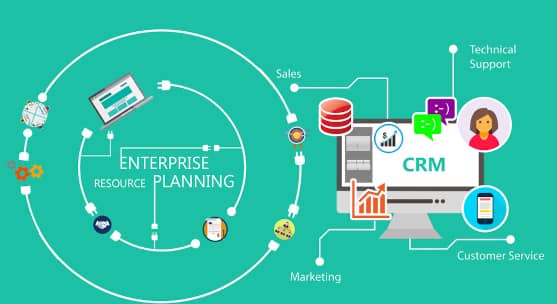Original name is the Enterprise Resource Planning. This system have been developed in 1990, allows us to manage resources of the enterprise. In fact, ERP is an effective method of joining of the different departments and processes into an unified database. It’s efficiency is in the simplification of the data transferring process.
This conception have been proposed by the one of Gartner’s analytics in 1990. Several successful similar systems was in use in early-middle 90’. Their purpose was solely for large companies. Later, in early 2000’ appeared a lot of the similar systems, that have been oriented to the small and mid-sized companies.
As for today, use of an ERP system is exact condition that should be used in every public company. Starting at the end of the previous century, similar systems, that have been used only by major industrial companies are used by large companies regardless of country, industry and ownership.
Key principles of the system
ERP system is peculiar to a number of principles:
- A key feature of the strategy of this type appears to be operating with a single transaction system. It allows to process most of the operations and business processes, which take place in the organization. Another requirement is a consolidation of all operations into a single database for further processing and to obtain a balanced plans (in real time).
- Replicability, which tells us that the same program package could be used for different organisations. It is possible to use different extensions and settings for each client.
- Unified system support a lot of language translations and currencies, which is based on necessity of the ERP system in a geographically distributed companies.
- The use of system in different industries, on the one hand imposes on certain requirements for versatility - and, on the other hand, support for industry-specific extensibility. There are specialized modules and extensions that focus on different areas.
Development of an ERP system with PHP programming language.
Nowadays, one of the basic environments to develop ERP system is PHP programming language. PHP allows us to create powerful algorithms, that allows us to work with large companies. Development consists of several parts, let’s take a closer look at them one by one.
Writing technical specifications
One of the most valuable parts of creating an ERP system is preparing competent technical specifications. It all starts with the getting brief on the development, provided by the client. So, this part consists of building an ERP system, but on paper - in general.
Result of this work - the exclusion of any misunderstandings between the customer and the performer. Complete picture of how would look and function final version of an ERP system.
As usual, the process of completing technical specifications takes from 5 to 20 work days, which includes all of the discussions and negotiations. Cost of this step is usually about 10% of total cost of the project.
Features of the development of ERP system
Development is a “revival” of the system, that existed only on paper before - in a form of technical specifications.This step also includes testing of the system, with help of the employees of the developer’s team.
In creation of the ERP system, we use modern web-technologies, and open-source software, such as: web-servers Nginx and Apache, UNIX/Linux operating systems, and MySQL database management system. Source code is written on the programming language PHP. The cost of the system for the customer is generated from the price of the license, customization and implementation of ERP. From the formation of the order to the implementation of the system until its final run can pass both as 3-4 months and 2 years. The distributed load on the master and slave server allows in case of failure to switch between them during 5-10 minutes. The development is considered to be the longest period in the work, and may last for one to six months, depending on the complexity of the ERP-system. Most of the projects to build from scratch will take about two to three months of development.
Implementation of the system
First step in the implementation of the system is import into the business data system. It is actually the data about clients, and all the other information, that client provides in the electronic form. Right after, our specialists start to install system onto servers, and start to set up system.
Next step is the learning process of coordinator on the client’s side. Coordinator could be anyone, who is responsible enough, with knowledge of business processes of the company. His role in this process is, basically, teaching the employees of the customer how to work with ERP system, and communication with developer of the ERP system about different improvements and bug fixes, that could occur in the process of development of the system, and her exploitation after launch. Tutoring the coordinator - is task for employees of the developer’s company. Often implementation of the product is one of the most difficult part of the project overall, which requires a lot of patience and persistence both from head of the company, as well as their employees.
Why ERP?
Management of the companies prefer this system because it allows to achieve the following objectives:
- Integration of financial information;
- Combining data on orders;
- Acceleration and standardization of the production process, regardless of the industry;
- Balance stocks
- Organization information on personnel.
Guided by these five reasons, many enterprises significantly improve their efficiency.
Warranty and technical support
Warranty comes in when the full-time exploitation of the system began. In this state of project specialists of the developer are removing small bugs and implementing some fixes to already finished project. After that, technical support stage kicks in - which is paid monthly by customer.















